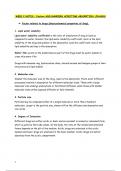WEEK 2 NOTES : Factors AND BARRIERS AFFECTING ABSORPTION. (PHA426)
➔ Factor related to drugs [physicochemical properties of drug].
1. Lipid water solubility
Lipid water solubility coefficient is the ratio of dissolution of drug in lipid as
compared to water. Greater the lipid water solubility coefficient, more is the lipid
solubility of the drug and greater is the absorption. Less the coefficient, less is the
lipid solubility and less is the absorption.
Water film exists on the membranes so part of the drugs must be water soluble to
cross this water film
Drugs with benzene ring, hydrocarbon chain, steroid nucleus and halogen groups in their
structures are lipid soluble.
2. Molecular size
Smaller the molecular size of the drug, rapid is the absorption. There exist different
processes involved in absorption for different molecular sizes. Those with a large
molecular size undergo endocytosis or facilitated diffusion, while those with smaller
molecular sizes utilise aqueous diffusion or lipid channels.
3. Particle size
Particles may be composed either of a single molecule or more than a hundred
molecules. Larger is the particle size, slower will be the diffusion and absorption and
vice versa.
4. Degree of Ionization
Different drugs are either acidic or basic and are present in ionised or unionised form,
which is given by their pKa values. In the body, the ratio of the ionised and unionized
forms depends on the pH of the medium. Acidic drugs are unionized in the acidic
medium and basic drugs are unionized in the basic medium. Acidic drugs are better
absorbed from the acidic compartment.
1
,5. Physical Forms
Drugs may exist as solids, liquids or gases. Gases are rapidly absorbed than the liquids,
while the liquids are rapidly absorbed than the solids. Thus the drugs in syrup or
suspension form are more rapidly absorbed than the tablets or capsules. Volatile gases
used in general anaesthesia are quickly absorbed through the pulmonary route.
6. Chemical Nature
Chemical nature is responsible for the selection of the route of administration of
drugs. Drugs that cannot be absorbed through the intestines are given by the
parenteral route. Examples include heparin which is large molecular weight, and cannot
be given orally. Similarly, benzyl penicillin is degraded in the GIT, so is given
parenterally. Salt forms of drugs are better absorbed than the organic compounds
when given orally. The organic compounds are given by routes other than the oral or
enteral route. Drugs in inorganic form are better absorbed than organic forms e.g. iron
in Fe+2 is better absorbed than Fe+3, d-tubocurarine exists in ionised form and is a
quaternary ammonium compound. Neostigmine is also a quaternary ammonium compound.
7. Dosage Forms
Dosage forms affect the rate and extent of absorption. A drug can be given in the
form of tablets, capsules or transdermal packets. Injections may be aqueous or oily.
This changes the rate of absorption. Examples include nitroglycerin which when given
by sublingual route, disintegrates rapidly but stays for a shorter duration. When it is
given orally, it disintegrates slowly and stays for a longer duration. When given by
transdermal route, the drug can cover an even longer duration.
a. Disintegration:
Disintegration is the breaking up of the dosage form into smaller particles. When rapid
is the disintegration, rapid will be the absorption.
b. Dissolution:
After disintegration, the drug dissolves in the gastric juices, which is called dissolution.
It is only then that the drug can be absorbed. When these two processes occur rapidly,
the rate of absorption increases.
8. Formulation
When the drugs are formed, apart from the active form some inert substances are
included. These are the diluents, excipients and the binders.
2
, Normally they are inert, but if they interact, they can change the bioavailability.
Examples include Na+ which can interact to decrease the absorption. Atropine is
required by some patients only in amounts of 0.2 to 0.6
9. Concentration
According to Fick’s law, higher the concentration more flux occurs across the
membrane. The rate is less affected than the extent of absorption.
Factors Related to Body
1. Area of Absorptive Surface
Area of absorptive surface affects the oral as well as other routes. Most of the drugs
are given orally because of the large area of absorptive surface, so that greater
absorption occurs. Intestinal resection decreases the surface area leading to a
decreased absorption. Similarly, when the topically acting drugs are applied on a large
surface area, they are better absorbed. Organophosphate compounds are highly lipid
soluble and poisoning can occur even by absorption through skin.
2. Vascularity
More the vascularity, more is the rate and extent of absorption and vice versa. In
shock, blood supply to the GIT is less so the oral route of drug administration is
affected. The blood flow to the peripheries is decreased, so absorption in those areas
is diminished as well. Therefore, intravenous route is preferred in case of shock.
Vasoconstrictors decrease the blood supply of an area, thus are useful to restrict the
local anesthesias so that they remain for a longer duration. Their wash away as well as
their toxic effects are decreased in this way. Massage in intramuscular injections
improves vascular supply to enhance absorption.
3. pH
Acidic pH favors acidic drug absorption while basic pH is better for basic drugs.
4. Presence of other Substances
Foods or drugs may interact with the drugs to alter their rate of absorption. Especially
for the drugs given orally, food can increase or decrease the absorption.
Antihyperlipidemic drugs like statins are better absorbed when taken with food.
3




